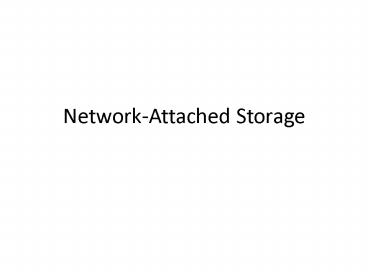Network-Attached Storage - PowerPoint PPT Presentation
1 / 17
Title: Network-Attached Storage
1
Network-Attached Storage
2
Network-attached storage devices
- Attached to a local area network, generally an
Ethernet-based network environment
3
Network-attached storage devices
- Assigned their own IP address
192.168.221.50
4
Network-attached storage devices
- Allow for multiple computers to access data
5
Network-attached storage devices
- Able to comprise of single or multiple disks and
can utilize technologies such as RAID
6
Network-attached storage devices
- Comprises of
- hard disk storage
- can include multi-disk and/or RAID systems
- software for configuring and file locations
mapping to the network-attached device
7
Redundant Array of Independent Disks
- also known as RAID
- a way of combining the storage capabilities of
more than one hard disk for enhanced purposes,
including - an increase in performance
- fault tolerance.
- Several different configurations of RAID
- Most Common include RAID 0, RAID 1, and RAID 5
8
RAID 0
- also referred to as disk striping
- data is written across multiple drives
simultaneously
9
RAID 0
- Benefits
- speeds up the traditional transfer speed of data
- Disadvantages
- provides no fault tolerance
- Should a single drive in a RAID 0 array fail, all
content is lost as content is distributed in bits
across multiple drives.
10
RAID 1
- also referred to as disk mirroring
- creates an exact duplicate of data written two
separate disks
11
RAID 1
- Benefits
- Provides fault tolerance
- In the event of a disk failure, RAID 1 allows for
the quickest and easiest method of data retrieval
by switching to the backup or alternative drive. - Disadvantages
- is costly because all storage needs are doubled
to account for the space redundancy, and there is
no increase in data access
12
RAID 5
- combines the benefits of both RAID 0 and RAID 1
- speeds up the traditional transfer speed of data
- Provides fault tolerance
13
RAID 5
- uses a parity block interleaved across all the
disks in the array, in addition to striping the
data across the same drives.
14
Parity
- is done by storing an extra bit with and based
on each byte in memory. - When a byte is accessed, the validity of the
parity bit is checked.
15
RAID continued
- The higher number does not signify a later or
better implementation of RAID - RAID 30 gt RAID 10
16
RAID continued
- However, certain number may signify the
implementation of two RAID structure such as RAID
10 or RAID 01, which are combinations of RAID 1
and RAID 0.
17
Images borrowed from
- http//www.hdd-tool.com/raid/raid-0-features-advan
tage-and-disadvantage.htm - http//www.raids.co.uk/raid_01.htm
- http//networkingpupil.blogspot.com/2010/10/nas_03
.html - http//hothardware.com/Reviews/Thecus-N7700-Networ
k-Attached-Storage-Server/ - http//www.nasreview.org/d-link-2-bay-network-atta
ched-storage-enclosure-dns-323/1 - http//benchmarkreviews.com/index.php?optioncom_c
ontenttaskviewid58Itemid70































